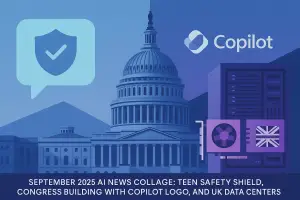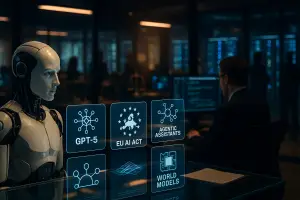The intersection of artificial intelligence (AI) and creativity has sparked a heated and complex debate: can machines truly replace artists, writers, and musicians? As AI technology continues to evolve at a rapid pace, its influence on creative industries is becoming more profound. AI-generated art, music, and literature have started to reshape traditional artistic domains, raising important questions about creativity, authenticity, and ownership in a machine-driven world.
The Rise of AI-Generated Art, Music, and Literature
AI has made extraordinary strides in producing creative works that mirror human ingenuity. Advanced models such as OpenAI’s DALL·E and ChatGPT generate visually stunning artwork and compelling written content, while music composition tools like AIVA, Jukedeck, and Amper Music create original musical scores across a variety of genres. These AI systems analyze massive datasets of existing works to identify patterns, styles, and structures, allowing them to produce content that rivals human-made creations in complexity, style, and originality.
In the visual arts, AI-powered models generate paintings, digital illustrations, and intricate designs based on user prompts or stylistic influences. For instance, generative adversarial networks (GANs) have been employed to create artwork that has fetched thousands of dollars at elite art auctions, blurring the line between human and machine artistry. In literature, AI has been used to craft poetry, fiction, and even full-length novels, with some AI-authored stories challenging readers to discern whether they were penned by a human or a machine. Music composition has similarly been transformed, with AI generating symphonies, pop songs, and experimental tracks that are often indistinguishable from those composed by human musicians.
AI-generated creative content is no longer confined to experimental projects but is now entering mainstream commercial sectors. Brands are using AI to develop engaging advertisements, musicians are incorporating AI into their compositions, and writers are using AI as a co-author to brainstorm ideas and enhance narratives. This widespread adoption signals a significant transformation in how creative industries operate.
The Pros and Cons of AI in Creative Industries
Pros:
- Accessibility and Efficiency: AI tools empower individuals without formal artistic training to produce high-quality content, lowering barriers to entry in creative fields. This democratization of creativity means that anyone with access to AI tools can experiment with art, music, and writing, fostering diversity in creative outputs. Aspiring creators can now bring their ideas to life without needing expensive equipment or years of training.
- Cost Reduction: Businesses and content creators can reduce production costs by automating repetitive or time-consuming creative tasks. Marketing campaigns, video editing, and even music scoring can be streamlined, freeing up budgets for other business operations. Small businesses and startups particularly benefit from reduced reliance on costly creative services.
- Innovation and Experimentation: AI can generate novel artistic concepts by combining ideas and styles in ways that humans might not envision, fostering new forms of artistic expression. AI systems can explore countless iterations rapidly, allowing creators to test and refine their ideas with unprecedented speed. This accelerates the discovery of unique art styles, musical genres, and literary techniques.
- Scalability and Personalization: Brands can leverage AI to produce large-scale, personalized content tailored to diverse audiences and marketing needs. Personalized marketing campaigns, tailored music playlists, and custom art pieces can be created en masse, enhancing user engagement and satisfaction. This scalability allows businesses to meet growing content demands while maintaining relevance.
- Speed of Production: AI can produce creative content at speeds far beyond human capability, enabling rapid project completion and iteration. This is particularly advantageous in fast-moving industries like advertising, where timely content is critical. Quick turnaround times empower creators to respond to trends and market demands with agility.
Cons:
- Job Displacement: The increasing use of AI in creative roles could threaten jobs for artists, writers, musicians, and other creatives as demand for human labor declines. Entire sectors, such as graphic design or copywriting, could face automation, potentially leading to economic displacement and the erosion of traditional creative professions.
- Loss of Authenticity: Critics argue that AI lacks emotional depth, lived experience, and genuine human expression, resulting in work that may feel soulless or mechanical. The nuance and imperfections that give human-created art its authenticity are often absent in AI-generated works, raising concerns about the erosion of cultural and emotional richness in art.
- Ethical and Legal Concerns: AI models often use existing creative works for training without consent, raising concerns about plagiarism, exploitation, and intellectual property rights. Artists and creators may find their work replicated or incorporated into AI outputs without recognition or compensation, leading to disputes over copyright infringement and ethical use.
- Quality Control and Bias: AI-generated content can sometimes produce subpar or biased outputs, reflecting flaws in training data or algorithms. Bias in training data can result in content that perpetuates stereotypes or excludes certain perspectives, compromising the inclusivity and quality of creative works.
- Legal Uncertainty: The lack of consistent global regulations regarding AI-generated content creates legal and commercial challenges for creators and businesses. Without clear guidelines, creators face hurdles in protecting their intellectual property, while businesses risk legal repercussions for using AI-generated content without proper authorization.
The Future of Human and AI Collaboration
Rather than completely replacing human creators, many industry experts believe that AI will serve as a powerful collaborator in the creative process. Artists may utilize AI to brainstorm ideas, experiment with styles, or automate tedious aspects of production, freeing up more time for meaningful creative expression. Musicians are already partnering with AI to compose innovative music, blending human intuition with machine precision. Writers use AI to overcome writer’s block, develop storylines, and enhance narrative structure.
Creative industries are likely to evolve toward hybrid workflows, where AI amplifies human creativity without supplanting it. This symbiotic relationship could usher in a new era of artistic innovation, unlocking possibilities previously unattainable. The fusion of human ingenuity and AI efficiency may lead to more diverse and experimental art forms, redefining what it means to be creative in the digital age.
Freaky Fact
Did you know that in 2018, an AI-generated painting titled Portrait of Edmond de Belamy sold for over $432,000 at auction? Created by a Paris-based art collective using a generative adversarial network (GAN), this artwork ignited global debates about the legitimacy, value, and future of AI-generated art.
Conclusion
AI’s growing presence in art, music, and literature is fundamentally reshaping the creative landscape. It challenges traditional concepts of creativity, ownership, and authenticity, sparking debates across legal, ethical, and artistic domains. While machines may not fully replace human creators, their influence is undeniable, ushering in a future where human imagination and machine intelligence coexist and collaborate.
Disclaimer: This article is for informational purposes only and does not constitute legal or financial advice.


